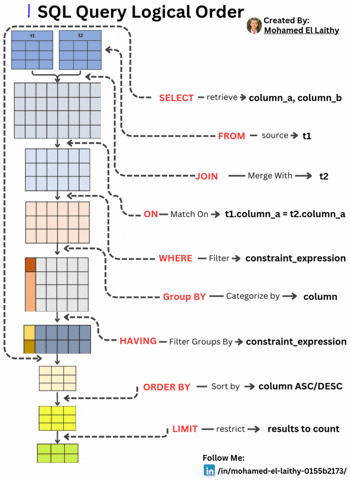This content originally appeared on DEV Community and was authored by Mohamed El Laithy
SQL Query Logical Order: A Step-by-Step Breakdown
Understanding the logical execution order of an SQL query is essential for writing optimized and efficient database queries. Unlike the typical SQL syntax order, the execution follows a systematic approach. Here’s a breakdown:
FROM – Identifying the Data Source
The query execution starts by selecting the main table (t1) from which data will be retrieved. This step lays the foundation for subsequent operations.JOIN – Merging Tables
If multiple tables are involved, the JOIN operation merges another table (t2) based on specified conditions, preparing a unified dataset for filtering and processing.ON – Defining Match Conditions
The ON clause establishes the conditions for the JOIN, ensuring the correct records are linked, typically using a primary-foreign key relationship (e.g., t1.column_a = t2.column_a).WHERE – Filtering Rows
The WHERE clause applies constraints to filter rows before any aggregation or grouping occurs, enhancing query performance by reducing unnecessary computations.GROUP BY – Categorizing Data
Data is then grouped based on a specific column, enabling aggregate functions like COUNT(), SUM(), and AVG() to operate on each group efficiently.HAVING – Filtering Groups
Unlike WHERE, which filters individual rows, HAVING filters grouped results based on conditions like HAVING COUNT(*) > 10.ORDER BY – Sorting the Results
The query results are then sorted in ascending (ASC) or descending (DESC) order based on one or more columns, ensuring structured output.LIMIT – Restricting the Output
Finally, the LIMIT clause restricts the number of rows returned, optimizing performance and preventing unnecessary data retrieval.
 Mastering SQL execution order helps in writing efficient queries, reducing execution time, and optimizing database performance. What’s your go-to SQL optimization tip?
Mastering SQL execution order helps in writing efficient queries, reducing execution time, and optimizing database performance. What’s your go-to SQL optimization tip?
follow me on LinkedIn for more animated software diagrams linkedin
This content originally appeared on DEV Community and was authored by Mohamed El Laithy
